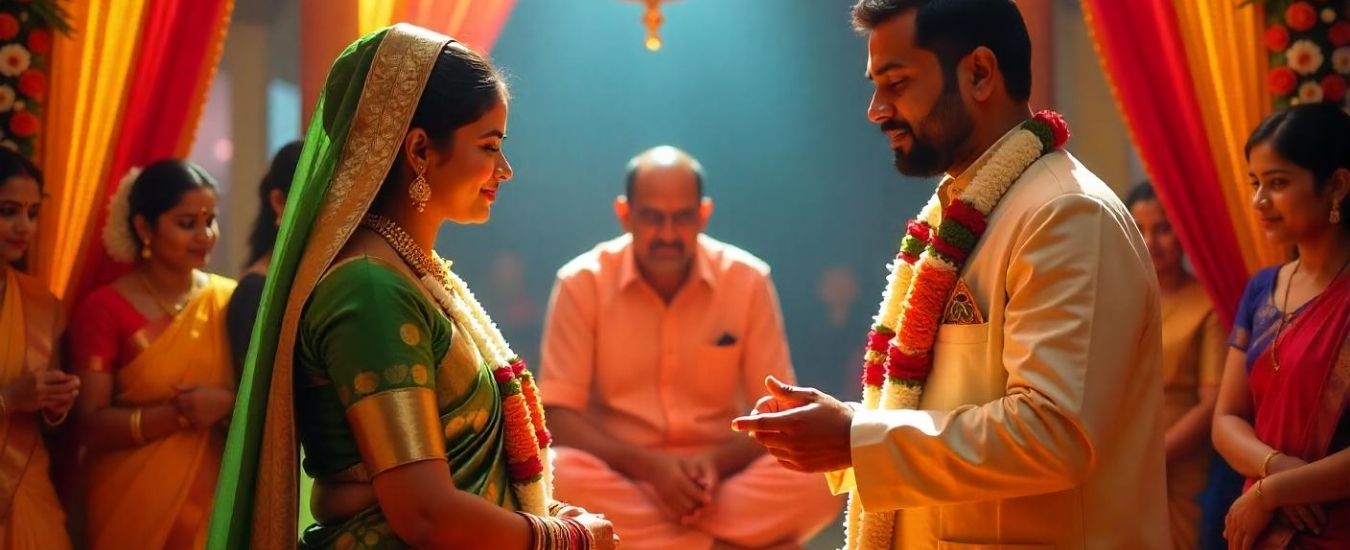Mangalashtak is not just a chant; it’s the soulful soundtrack to a Hindu marital ceremony, anchoring it in Sanskrit wisdom, spiritual discipline, and familial affection. Whether you’re the couple, a parent, or a guest—when these verses begin, you’re part of something timeless and divine.
A Vibrant Cultural Tapestry
Marathi weddings are a Vivaah Sanskar deeply embedded in colours, music, and spiritually rich customs. From the Haldi ceremony to Grihapravesh, every ritual carries symbolism rooted in Dharma. Yet, one element echoes across generations — the Mangalashtak.
Importance of Traditions in Marathi Marriages
In an era moving toward minimalism, these Hindu Samskaras serve as the cultural glue binding families. The Mangalashtak, beyond its lyrical beauty, is a divine mantra path—bestowing blessings for the matrimonial alliance.
What is Mangalashtak?
Literal Meaning and Etymology
‘Mangal’ means ‘auspicious’, and ‘Ashtak’ signifies ‘eightfold’. Thus, Mangalashtak refers to eight Vedic shlokas recited as spiritual invocations during a wedding.
When and How It’s Recited
Traditionally chanted during the Antarpat ritual — just before the couple sees each other — these verses precede the lowering of the cloth separating the bride and groom, marking the start of their journey under Agni Sakshi.
Origin and Cultural Roots
Ancient Vedic Influences
The Mangalashtak finds its roots in Rigveda hymns, embodying Sanskrit shlokas blended with Maharashtrian customs and metaphysical alignment.
Regional Interpretation
In Maharashtra, families personalize the verses, infusing them with ancestral traditions and familial bonding, making each recitation uniquely sacred.
The Eight Sacred Verses: What They Mean
Each verse acts as a Prarthana to a deity — invoking cosmic harmony:
- Ganesha – Removes obstacles
- Saraswati – Grants wisdom
- Vishnu – Offers protection
- Lakshmi – Brings prosperity
- Shiva – Ensures harmony
- Parvati – Strengthens the bride
- Navagrahas – Align planetary energies
- Ancestors & elders – Offer eternal guidance
Role of Mangalashtak in the Wedding Ceremony
During the Lagna ritual, the Antarpat cloth is lowered as the pandit recites the verses. The ambience is sanctified with the vibration of mantras, invoking spiritual union and Moksha pathways.
Impact on the Bride and Groom
Many couples recall the emotional transcendence during Mangalashtak. The sacred sound, rich with spiritual frequency, fosters cosmic unity and emotional bonding.
Who Recites the Mangalashtak?
A Brahmin pandit, trained in Vedic intonation, typically leads the chant. Elders often join in, creating a collective vibration of blessings and familial participation.
Instruments and Soundscapes
The background echoes with the Shehnai, the conch shell, and often classical instrumental music — transforming the wedding mandap into a spiritual sanctum.
Comparison with Other Indian Wedding Chants
- Tamil: Mangala Isai
- Bengali: Uludhwani, Shubho Drishti
- Punjabi: Laavan from Guru Granth Sahib
Mangalashtak, however, stands out in its eightfold divine architecture, combining deity invocation with ancestral reverence.
Modern-Day Relevance
Even in destination weddings or court marriages, Marathi families preserve the ritual structure by incorporating digital elements—QR-coded invites, bilingual translations, or live streaming of the ceremony.
Misconceptions Debunked
Some dismiss it as background music, but it’s a sacred Vedic chant designed to realign karma and cosmic energy. It’s not just about deities but encompasses ancestral homage and planetary harmony.
Preserving the Tradition for Gen Z
Parents and elders must convey the meaning behind these rituals. Using animated explainers, interactive wedding apps, and printed translations in the wedding program bridges the generation gap.
Mangalashtak in Films and Music
Seen in films like Sairat, Natsamrat, and Katyar Kaljat Ghusli, the Mangalashtak moments evoke nostalgia and reverence.
FAQs
Why are there eight verses in Mangalashtak?
The number eight symbolizes completeness and invokes blessings from various deities representing different life aspects — from wisdom to prosperity.
Can Mangalashtak be recited at other ceremonies?
Traditionally, it’s specific to weddings, but it may also be chanted during engagements or anniversaries as a blessing.
Is Mangalashtak only for Marathi weddings?
Primarily, yes, but other Maharashtrian communities like Konkanis and Deshastha Brahmins may also incorporate it.
Who wrote or composed the original Mangalashtak?
The verses are attributed to Vedic sources and passed down through oral traditions. The exact authorship remains unclear.
What’s the spiritual significance of each verse?
Each verse is a prayer to a different deity or cosmic force, ensuring the couple receives well-rounded divine support for their new journey.
